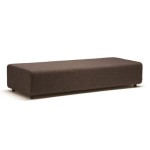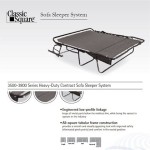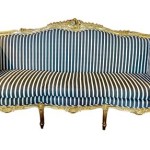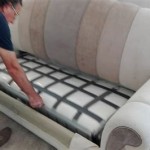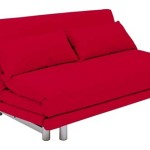Fixing a Sagging Sofa: Restoring Comfort and Support
A sagging sofa is a common household problem that can significantly impact comfort and aesthetics. Over time, the internal components of a sofa, such as the cushions, springs, and frame, can weaken and degrade, leading to a noticeable dip or sag in the seating area. This not only diminishes the sofa's visual appeal but can also cause discomfort and even contribute to back pain due to improper support.
Addressing a sagging sofa promptly can prevent further damage and extend the lifespan of the furniture. Depending on the severity of the sag and the type of sofa construction, various repair methods can be employed. This article provides a comprehensive guide to diagnosing the causes of a sagging sofa and exploring effective strategies for restoring its original comfort and support.
Identifying the Cause of the Sag
Before attempting to repair a sagging sofa, it is crucial to identify the underlying cause of the problem. Several factors can contribute to a sofa's sagging condition, and understanding these factors will guide the selection of the appropriate repair technique.
Worn-Out Cushions: The most common culprit behind a sagging sofa is deteriorated cushions. Sofa cushions are typically filled with foam, fiber, or a combination of both. Over time, these materials compress and lose their resilience, leading to a flattened and sagging appearance. The frequency of use, the quality of the filling material, and exposure to direct sunlight can all accelerate cushion deterioration.
Weakened Springs: Many sofas rely on internal springs for support. These springs, which can be coil springs, sinuous springs (also known as S-springs), or a combination of both, provide the necessary give and support for comfortable seating. With prolonged use, springs can become stretched, broken, or detached from the frame, resulting in a noticeable sag. Sinuous springs are particularly prone to sagging if the support straps are damaged.
Damaged Frame: The sofa's frame provides the structural foundation for the entire piece of furniture. If the frame is damaged, weakened, or warped, it can cause the entire sofa to sag. Frame damage can occur due to excessive weight, improper handling, or underlying issues like wood rot or insect infestation. A weakened frame will compromise the support provided to the cushions and springs, leading to a general sagging sensation.
Worn Support Webbing: Some sofas, particularly those with a more modern design, utilize support webbing instead of traditional springs. This webbing, usually made of elastic or jute, provides a flexible support system for the cushions. Over time, this webbing can stretch, sag, or even break, resulting in a lack of support and a noticeable dip in the seating area. The quality of the webbing and the weight it bears are important factors affecting its longevity.
Repairing Sagging Cushions
If the sagging is primarily attributed to worn-out cushions, several repair options can be considered, ranging from simple solutions to more involved restoration methods.
Cushion Refilling: A straightforward approach is to replace or add filling to the existing cushions. This can be achieved by opening the cushion casing and adding new foam, fiber, or a combination of both to restore the cushion's original loft and firmness. The type of filling material used will significantly impact the cushion's comfort and durability. High-density foam offers excellent support and longevity, while fiber provides a softer, more plush feel. A combination of both materials can provide a balance between support and comfort. Carefully stitching the cushion casing closed after refilling ensures a neat and professional finish. Consider adding a layer of batting around the foam to prevent it from rubbing against the fabric.
Cushion Replacement: In cases where the original cushions are severely deteriorated or irreparably damaged, replacing them entirely may be the most effective solution. This involves ordering new cushions that are specifically designed to fit the sofa's dimensions and style. When selecting replacement cushions, it is essential to consider the density and type of filling material, as well as the overall dimensions and shape of the cushion. Custom-made cushions can ensure a perfect fit and allow for personalized comfort preferences.
Cushion Rotation and Flipping: A simple but often overlooked technique is to regularly rotate and flip the cushions. This helps to distribute wear evenly and prevent localized sagging. By rotating and flipping the cushions, the areas that receive the most use are given a chance to recover, extending the lifespan of the cushions and maintaining a more uniform level of support. This is a preventative measure that can be easily incorporated into a regular cleaning routine.
Adding Support Under Cushions: Sometimes the issue isn't necessarily the cushions themselves, but the support system below them. Adding a piece of plywood cut to the size of the seating area underneath the cushions can provide additional support and prevent sagging. This is a cost-effective solution for sofas with relatively flat seating areas and can be particularly helpful if the frame is slightly weakened. The plywood should be smooth and free of splinters to avoid damaging the cushion covers.
Addressing Weakened Springs and Support Webbing
If the sagging is caused by weakened springs or damaged support webbing, the repair process will involve addressing these underlying structural components.
Spring Repair and Replacement: If the sofa utilizes coil springs, inspect them for signs of damage, such as broken coils or detached springs. Broken springs can be replaced with new ones readily available at most hardware stores or upholstery supply shops. Detached springs can be reattached to the frame using spring clips or specialized upholstery staples. For sofas with sinuous springs, check the spring supports. These supports, often made of metal or plastic, can break or detach, causing the springs to sag. Replacing or reinforcing these supports is essential for restoring the spring's functionality. Consider adding additional support straps alongside existing ones to increase the overall support system.
Webbing Replacement: If the support webbing is stretched, sagging, or broken, it will need to be replaced. This involves removing the old webbing and installing new webbing in its place. Upholstery webbing is available in various widths and materials, so it is important to select a webbing that is appropriate for the sofa's design and the weight it needs to support. The new webbing should be securely attached to the frame using upholstery staples or tacks. Ensuring consistent tension across the webbing is crucial for providing uniform support. Use a webbing stretcher tool to ensure the webbing is taut before securing it to the frame.
Reinforcing the Frame: If the sofa's frame is weakened or damaged, it may need to be reinforced or repaired. Minor cracks or splits can be repaired with wood glue and clamps. More significant damage may require the replacement of damaged frame members. Adding additional support beams or corner braces can also strengthen the frame and prevent further sagging. Professional furniture repair services can handle more complex frame repairs, ensuring structural integrity and longevity. Inspect the joints of the frame for looseness and tighten any screws or bolts. Consider adding wood screws or dowels to reinforce the joints if necessary.
Preventative Measures: To extend the life of your sofa and prevent future sagging, consider these preventative measures. Avoid placing excessive weight on specific areas of the sofa. Distribute weight evenly and avoid repeatedly sitting in the same spot. Regularly clean and maintain the sofa according to the manufacturer's instructions. This can help prevent the accumulation of dirt and debris, which can accelerate wear and tear. Protect the sofa from direct sunlight and extreme temperatures, as these can damage the upholstery and internal components. Periodically inspect the sofa for signs of wear and tear, such as loose springs, sagging cushions, or frame damage, and address these issues promptly to prevent them from escalating into more serious problems. Consider using furniture protectors or throws to minimize wear and tear on the upholstery and cushions.
By understanding the causes of a sagging sofa and implementing the appropriate repair strategies, it is possible to restore the furniture's comfort, support, and aesthetic appearance. In some cases, simple DIY repairs may be sufficient, while more complex issues may require the assistance of a professional upholstery or furniture repair service. Regular maintenance and preventative measures can help extend the lifespan of the sofa and prevent future sagging problems.

4 Ways To Fix Sagging Sofa Cushions Wikihow

3 Ways To Fix A Sagging Couch Or Sofa Simple And Easy Diy Springs Foam Supports

How To Fix Saggy Couch Cushions An Exercise In Frugality

How To Fix The Springs On Saggy Sofa Diy Furniture Studio

4 Ways To Fix Sagging Sofa Cushions Wikihow

How To Fix Sagging Couch Cushions Thistlewood Farm

How To Fix A Sagging Sofa Step By Checkatrade

How To Fix The Springs On Saggy Sofa Diy Furniture Studio

Fixing Sagging Sofa Cushions Guide Gb Foam Direct

How To Fix Sagging Couch Cushions Thistlewood Farm


